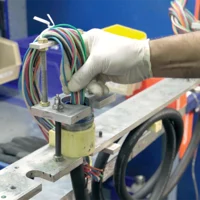Since implementing lean manufacturing principles, a topic we explore in our latest white paper, we’ve been able to improve the efficiency of our factory—making gains in safety, quality and productivity. Building on what we learned, we continue to look for new ways to eliminate non-value added tasks, which eat up unnecessary time, materials, labor, and floor space. We tackled floor space issues, increasing efficiency by making our manufacturing cells even smaller. Here’s how we did it.
The Kaizen-Based Process
Our company has been growing, which means we need more space for new products and equipment. Having smaller manufacturing cells has enabled us to add more cells to our factory floor. And by leaning out existing cells, we’ve been able to streamline the movement of people and equipment during the manufacturing process, leading to productivity gains.
Over the summer, we held kaizen events to help us brainstorm, design and implement these new cells. (You can read more about kaizen, a lean organizational philosophy, in our white paper here.) During these events, we tasked teams of people from across the organization with making existing cells smaller, as well as designing new ones entirely. These teams were made up of the people who performed the physical work within the cell, as well as supervisors, engineers and salespeople.
From Spaghetti Map To Completed Cell
We started by drawing “spaghetti maps,” which capture the current flow of the product from start to finish, including the motion of all people and equipment involved in that process. We looked at factors like length of travel, as well as the number of times the product crossed over its original path. Having too much crossover means the product can potentially confuse a worker or obstruct another part of the process, increasing the risk of quality errors.
Next, after mapping out the product in its current state, we drew a revised spaghetti map, making changes to the product’s flow as needed. As much as possible, we sought to keep the product moving forward while minimizing crossover and travel distance. We built and modified manufacturing cells based on these revised maps—a process that takes about two days per cell.
Re-evaluate legacy equipment
Another key aspect of reducing the size of our cells involved a re-evaluation of our equipment to see which pieces really fit our lean approach to manufacturing. Consider, for example, the ovens we use to cure epoxy.
Decades ago, we standardized on large industrial ovens for all of our work cells in lean manufacturing. Readily available and able to operate for extended periods with little maintenance, these ovens were a good choice at the time. But with their 36-inch-wide racks, they were optimized for large batch processing. When we moved to one-piece-flow manufacturing, we found we were only using 25-50% of the rack space.
So we switched to smaller ovens with 16-inch racks. The new ovens not only contributed to the reduced footprint of our work centers, they were also far better utilized and more efficient in our lean manufacturing system.
There was certainly some short-term pain from scrapping our legacy ovens, but the long-term efficiency gains made the switch more than worthwhile.
Results
Since the summer, we’ve been able to reduce the square footage of many of our lean manufacturing cells from 275 to 140-180 square feet. We’ve already seen many benefits from the reduction, including:
- Savings in power consumption
- 30% increase in productivity
- Ergonomic improvements
- Opportunities to use smaller, less expensive equipment
Contact us to learn about our hermetic sealing techniques, hermetic feedthrough technology, and how we can help you.
To learn more about lean in our job shop, download our latest white paper.


